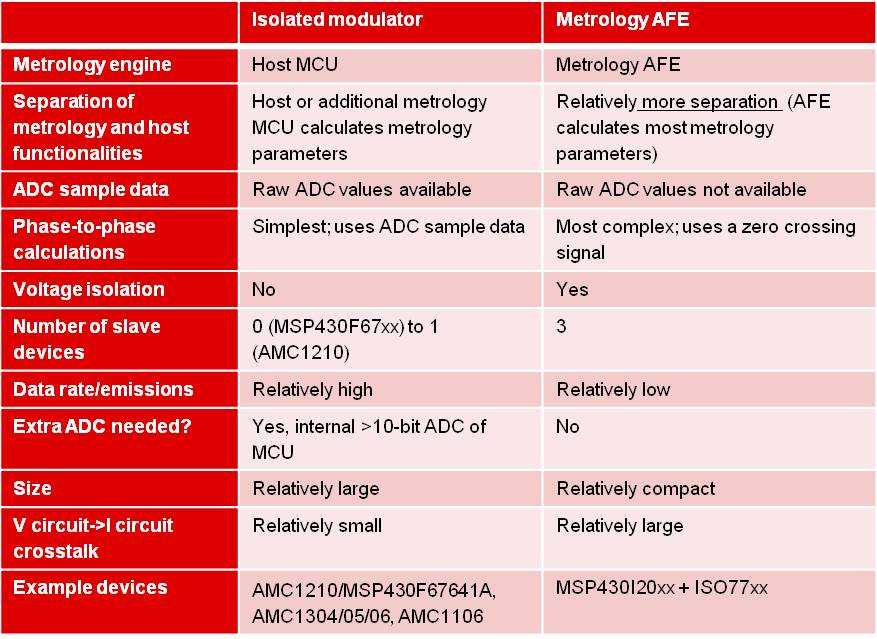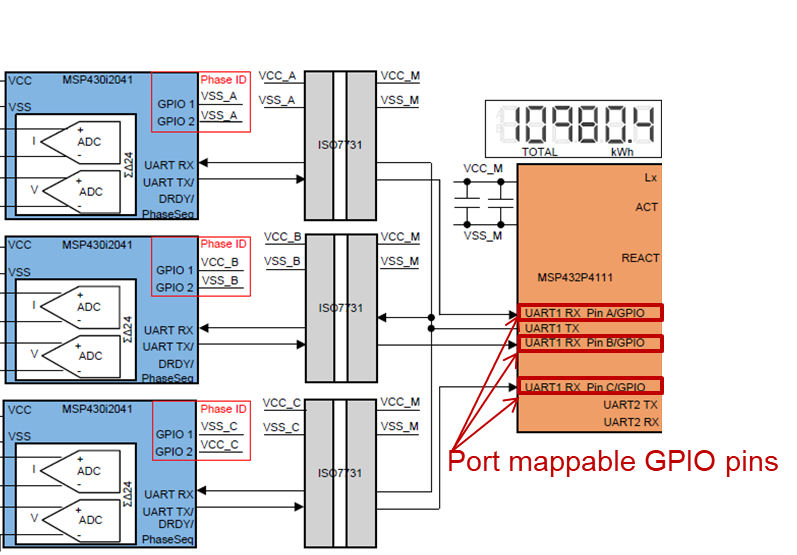SSZT600 october 2018 AMC1106M05 , AMC1210 , AMC1304M05 , ISO7731 , MSP430F67641A , MSP430I2041
In part 1 of this three-part series, I discussed the isolated shunt sensing building blocks, and in part 2, I presented an overview of two different shunt sensing architectures. In this installment, I will compare the two architectures.
Figure 1 summarizes the differences between the isolated modulator and metrology analog front end (AFE) shunt sensing architectures.

Figure 1 Comparing the Isolated Modulator and Metrology AFE Shunt Sensing Architectures
Metrology Calculations
In the isolated modulator architecture, the host/metrology microcontroller (MCU), not the isolated shunt sensing device, performs all metrology calculations. In the isolated metrology AFE architecture, the isolated shunt sensing device does the majority of calculations. This means that the isolated metrology AFE architecture offloads the work that the host MCU would otherwise do, which provides better separation between metrology and the host.
One disadvantage of this, however, is that since there isn’t one device with access to all of the raw analog-to-digital converter (ADC) data of the different phases, phase-to-phase calculations (such as determining the angle between different phase voltages) and advanced metrology analysis are more difficult with the isolated metrology AFE architecture compared to the isolated modulator architecture.
Voltage Isolation
One advantage of the isolated metrology AFE architecture is that it isolates both voltage and current since the isolated metrology AFE senses voltage in addition to current. In the isolated modulator architecture, voltage can only be isolated with additional circuitry.
Interfacing to Host MCU
An advantage of isolated modulator devices is that you do not have multiple devices sharing the same communication interface to the host MCU. If you’re using the AMC1210 stand-alone filter, then you only need to communicate to one AMC1210 device to get the current samples for as many as four channels. If you select an MCU with a digital filter, you can obtain the current ADC values directly from registers.
In comparison, when using the isolated metrology AFE architecture, you need to be able to share one universal asynchronous receiver transmitter (UART) receiver port of the host with three metrology AFEs, as shown in Figure 2.
 Figure 2 Metrology AFE Reference Design UART Receiver Port Mapping Multiplexing Scheme
Figure 2 Metrology AFE Reference Design UART Receiver Port Mapping Multiplexing SchemeData Rate
An advantage of the isolated metrology AFE architecture is that the rate at which data is sent is smaller than for the isolated modulator’s case. In the isolated metrology AFE design, data is sent out only once every second, with a baud rate of 57,600. For isolated modulator designs, the minimum data rate is 5-6MHz. The reduced data rate for the metrology AFE architecture means fewer issues with emissions.
Solution Size and Crosstalk
Another advantage of the isolated metrology AFE architecture is that it doesn’t require additional ADCs to sense the voltage like the isolated modulator architecture does. For the isolated modulator architecture, you would need to use at least a 10-bit ADC to sense the phase voltage, integrated within the host MCU. This would lead to the size of the isolated modulator designs being relatively larger than the isolated metrology AFE architecture.
However, one advantage of having the voltage sensed separately from the current is that there is less crosstalk from the voltage front-end circuitry to the current front-end circuitry. This voltage-to-current crosstalk is a factor in the energy percentage error seen at lower currents for the different architectures.
To summarize, the isolated modulator is good in systems that calculate advanced metrology parameters like harmonics and phase-to-phase measurements. The isolated metrology AFE architecture is good for low-emission, compact systems that require good separation of the metrology and host functions and only need basic metrology parameters calculated.
Additional Resources
- View all TI smart e-meter reference designs.
- Watch the Polyphase Current Measurement with Isolated Shunt Sensors training series.